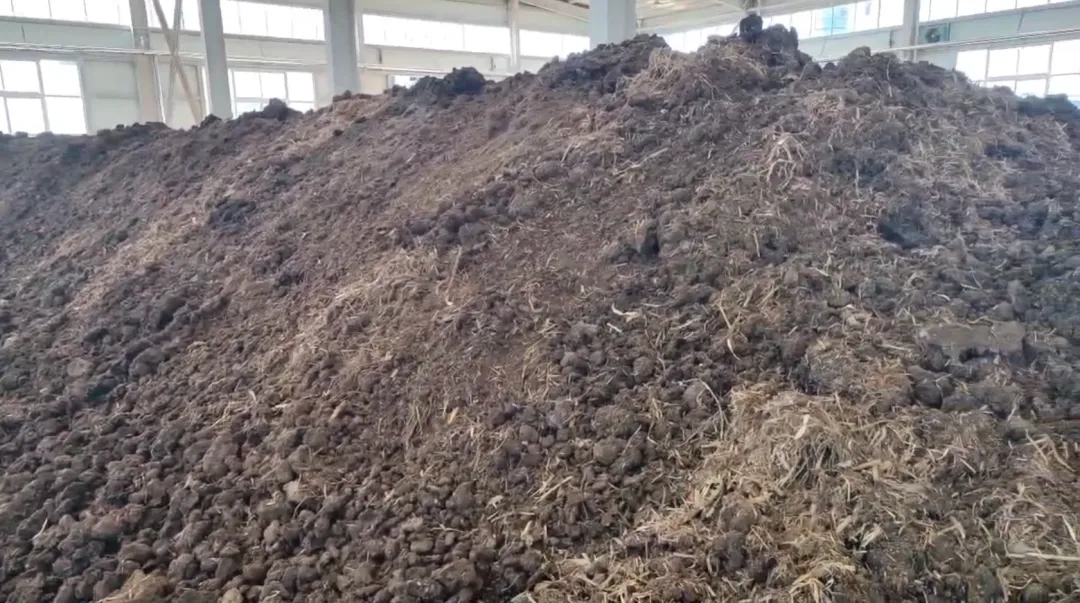Guidelines for biogas residue treatment
Biogas digester or septic tank is one of the environmental protection equipment used by many farms at present. It can collect and treat livestock and poultry waste and produce biogas through anaerobic fermentation. Biogas can be used as a clean energy source, which can not only meet the requirements of environmental protection for farms, but also reduce part of the operating costs. But what to do with the fully fermented digester residue?
In fact, the biogas residue after fermentation in the biogas digester is a very good raw material for organic fertilizer, and it can be used to ferment organic fertilizer after proper treatment.

Aerobic fermentation helps the conversion of biogas residue, and the prospect of green agriculture is promising
Biogas residue is the solid material left after fermentation of organic matter. Biogas residue is rich in organic matter, humic acid, micronutrient elements, a variety of amino acids, enzymes and beneficial microorganisms, which can play a very good role in improving soil.
Although biogas residue plays an important role in agricultural production, it contains many plant harmful substances and microorganisms that will affect plant growth and yield if not treated. First of all, the biogas residue is not treated, it has many uncontrollable factors, contains a large number of spirochaeta, viruses and other microorganisms, which brings great risks to plant growth; Secondly, some harmful plant substances contained in biogas residue, such as fungicides, will also affect the growth of plants, and may harm people's health. Therefore, the biogas residue needs to be scientifically treated before it can be safely used, and can not be used directly as fertilizer.
The processing of biogas residue in the form of high temperature aerobic fermentation compost is a necessary step to transform into fertilizer, and can simultaneously achieve waste reduction, resource utilization and harmless, which is of great significance in today's increasingly severe land shortage and energy shortage situation.
However, the existing technology of biogas residue high temperature aerobic fermentation composting device generally has the following problems:
Due to humidity, temperature and ventilation, the reactor body cannot be heated, the reactor body temperature is too high, and the reactor body temperature is not uniform. According to the different fermentation time of compost, the demand for temperature and water is different, the existing composting device can not independently control the water, temperature and other parameters between various regions, and can not realize the automation of composting. NCS Intelligent molecular membrane fermentation system: a tool for aerobic fermentation
Recently, we entered a Shandong new energy recycling industry demonstration base, in this industrial demonstration base, cow manure is not a pollutant, but has become a valuable resource. The base uses cow manure for anaerobic fermentation to produce biogas, biogas slurry and biogas residue. Among them, biogas can be used for gas-fired power generation and heating, biogas slurry can be used for farmland irrigation, and biogas residue can be further processed into organic fertilizer. The production of organic fertilizer in this industrial demonstration base is based on the advanced NCS intelligent molecular membrane fermentation system, which is a new type of aerobic fermentation technology. The molecular membrane microporous structure of the membrane covering material can prevent the odor generated during the composting process from being discharged to the external environment through the membrane, and can ensure the release of water vapor, and can avoid the impact of external environmental changes such as rain and snow on the composting process, so as to achieve open-air fermentation, environmental protection and odorless. China Sea Environment has many years of first-line fermentation experience, professional technicians adjust the water and carbon nitrogen ratio of match materials according to the material conditions to ensure the fermentation effect. In addition, the NCS intelligent molecular membrane fermentation system also has automatic operation function, scientific control of fermentation parameters, ensure appropriate reactor temperature, greatly reducing the difficulty of manual intervention and operation, and improve production efficiency. In addition, on the basis of traditional membrane composting technology, Zhonghai Environment has realized intelligent and mechanized systematic innovation from the front end of material pretreatment to the back end of film stripping, such as developing a series of supporting equipment such as solid-liquid separation equipment, wall-mounted film rolling machine, self-propelled rollover machine, trough film rollover machine, self-propelled film rollover machine, etc., improving the overall process. Help the technology show good composting efficiency, fermentation cycle and product effect. Moreover, in order to facilitate the application of products, we increase the supporting facilities such as organic fertilizer production lines and fertilizer sprinkling trucks, and create a complete chain from material collection, treatment and conversion to utilization through a systematic treatment process to solve organic waste treatment in one stop. Through the aerobic fermentation process of the NCS intelligent molecular membrane fermentation system, the biogas residue is converted into high-quality organic fertilizer. This organic fertilizer is rich in nitrogen, phosphorus, potassium and other nutrients required by plants, and has the characteristics of natural, safe and environmental protection. The use of this organic fertilizer can improve soil quality, improve crop yield and quality, and is an important cornerstone of green agricultural development. Through the practice of this new energy recycling industry demonstration base in Shandong, we have seen that waste has become a treasure. With advanced scientific and technological means, we can turn seemingly useless waste into valuable energy and resources, and inject new impetus into green development. This circular economy model is also of great significance for solving environmental problems and promoting green development.

 400-805-3612
400-805-3612
 sinoocean2010@163.com
sinoocean2010@163.com
 No. 36 Jinshui Road, Laoshan, Qingdao City
No. 36 Jinshui Road, Laoshan, Qingdao City



Copyright © 2023-2024 Qingdao Zhonghai Environmental Engineering Co., Ltd. Record number:鲁ICP备20013595号